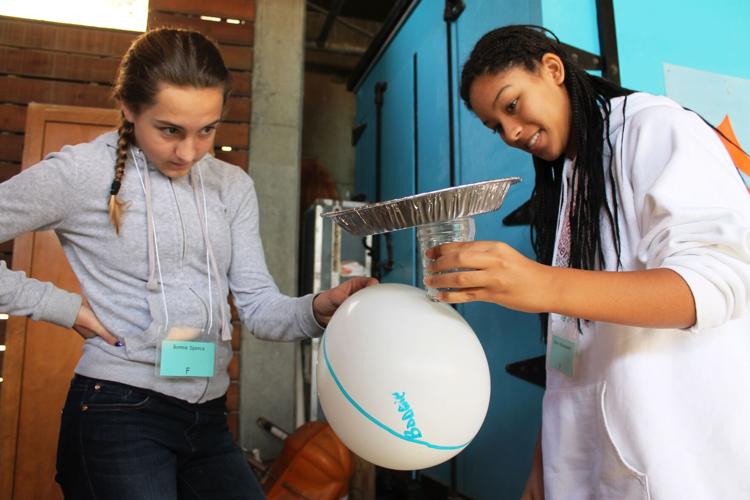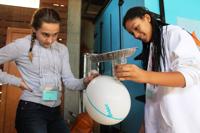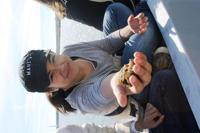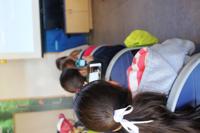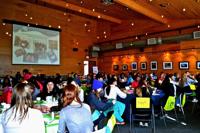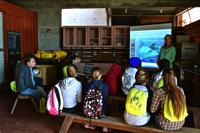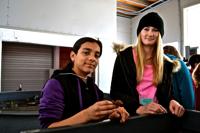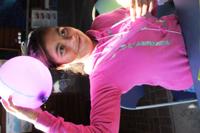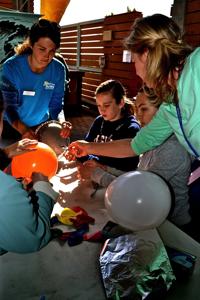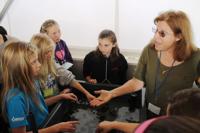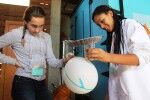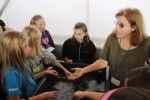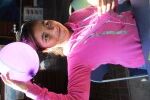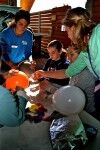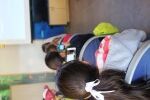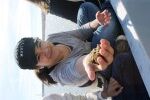Girls in Ocean Science conferences aim to inspire budding researchers

Girls in Ocean Science participants Bonnie Spence (left), 13, of San Clemente, and Nova Wassmann, 13, of Laguna Niguel, test elector receptor theories by replicating shark senses at the Ocean Institute on Saturday. Photo by Andrea Papagianis

Nearly 100 junior high-aged girls joined in a series of experiments and talks geared toward inspiring young scientists. Photo by Madison May

Leslie Harris, of the Natural History Museum of Los Angeles County, shows invasive species to young scientists. Photo by Andrea Papagianis

St. Lawrence of Brindisi Catholic School student, Valerie Avina, of Watts, participates in a static electricity experiment Saturday testing sharks’ electroreception senses. Photo by Andrea Papagianis

Stephany Viramontes (left) and Tasha Johnson check out invasive species at the Maddie James Seaside Learning Center. Photo by Madison May

Mikki McComb-Kobza, helps middle school students during an experiment testing a hypothesis about shark senses. Photo by Madison May

Middle school-aged girls listen on as Mikki McComb-Kobza shares her research on shark behaviors at the Ocean Institute. Photo by Madison May

Middle school students record a lecture on community-related science jobs. Photo by Andrea Papagianis

Trinity Migliaccio, 13, of Ladera Ranch, shows off an invasive species, known as sea squirt, at the Ocean Institute. Photo by Andrea Papagianis
By Andrea Papagianis
Growing up in Colorado, Mikki McComb-Kobza was surrounded by mountainous terrain.
But an encounter with the film Jaws as a child not only scared the daylights out of her, it also piqued her curiosity in ocean sciences, particularly where the often misunderstood fish are concerned. McComb-Kobza credits the film with sparking a passion and her lifelong work researching the sensory biology of sharks.
McComb-Kobza, a shark expert with a doctorate in biology, uses her research to promote shark conservation to keep the animals off of long lines. As the director of research and education for Ocean Classrooms, McComb-Kobza helps bring ocean sciences to the fingertips of students, and last weekend she joined seven other female scientists in Dana Point to inspire the next generation of great thinkers.
“It’s an honor and privilege to talk to young girls, to show them a career pathway and show them that it’s possible to become a scientist,” McComb-Kobza said. “I get to show them that science isn’t geeky or nerdy … and that they can have an amazing life and amazing adventures where they are always learning and experiencing something new.”

Mikki McComb-Kobza, helps middle school students during an experiment testing a hypothesis about shark senses. Photo by Madison May
Nearly 100 middle school-aged students from across the southwest, from San Diego and Los Angeles and as far as Arizona and Nevada, came together for the Ocean Institute’s annual Girls in Ocean Science Teen Conference on Saturday, to learn from one another and women in various aspects the science industry.
Armed with new knowledge on sharks’ keen senses, young scientists lined the walls of an outdoor institute classroom. With electroreception mimicking devices, made from glass jars, paper clips, aluminum foil and pie pans, girls playing sharks walked the room’s perimeter looking for their prey.
A small group of students held colorful balloons they had rubbed on their heads to create static electricity, others held onto balloons without a created electrical charge. One-by-one the sharks used their tools to find hiding prey. The experiment was a success. Students were able to recreate a shark’s sensory ability to detect weak electric fields, used to find prey in the water.
“Little research has been done on the taste sensation of sharks,” McComb-Kobza told the girls. “Maybe one of you someday, if you get jazzed about sharks, will let the world know.”
Female science professionals working in astronomy, atmospheric studies, oceanography, taxonomy, biology and more presented their work and conducted experiments with budding scientists during the ninth annual event, giving girls a hands-on experience and peek into the science world.
The road to the conference serves as a learning tool in and of itself, said the Ocean Institute’s Director of Environmental Programs Karen Jhawar. Jhawar, who also serves as the conferences coordinator, oversees the GIOS committee that makes all decisions pertaining to the event.
“They are a wonderful group of young women who are all very active within their own communities and schools, along with their committee responsibilities,” Jhawar said of the group.
From designing T-shirts and tote-bags to coordinating speakers and running experiments, the committee’s 23 members had a hand in all aspects of the day. Consisting of girls in middle and high school, college and a few parents, the committee is selected from past GIOS Conference attendees. Once selected from a pool of applicants, committee members are first tasked with suggesting and contacting potential speakers.

Leslie Harris, of the Natural History Museum of Los Angeles County, shows invasive species to young scientists. Photo by Andrea Papagianis
For this year’s middle school conference, committee members brought in scientists from the Scripps Institution of Oceanography, Natural History Museum of Los Angeles County, NASA’s Jet Propulsion Laboratory, National Oceanic and Atmospheric Administration, Southern California Edison, Sierra Streams Institute and Orange County Department of Education.
Leslie Harris, polychaete collections manager for the Natural History Museum, reached off the Maddie James Seaside Learning Center dock into the Dana Point Harbor. Pulling up an invasive species, known as a sea squirt, Harris pushes lightly showing a surprised group of teens how the sponge-like creature got its name. Participants erupted in laughter as water shot into the air.
“Why do we collect,” Harris asks the young students. “Because we are cultivating the past. If you go into marine sciences, or any sciences, that could be you. You could be going out to sea, out Hawaii, the Artic or Australia collecting examples.”
Participants also got a peek into science professions based on land, as Program Naturalist Erin Eberhardt with the county Department of Education’s Inside the Outdoors program, introduced other scientific possibilities right in students’ communities.
“This may be Girls in Ocean Science … but everything that happens on land impacts the sea,” Eberhardt told smart phone-wielding participants capturing each moment of her talk. “The thing about science is it overlaps all the time, if you start our studying sciences broadly, it can help you in the long run.”
Jhawar said receiving professional advice and participating in hands-on experiments outside of the classroom setting can help empower girls from a young age.
“Women are much underrepresented in science,” Jhawar said. “This program aims to get girls interested and thinking about their careers. We get to introduce them to amazing women who have made their careers and been successful in science. It just empowers them and gets them thinking about their future.”

